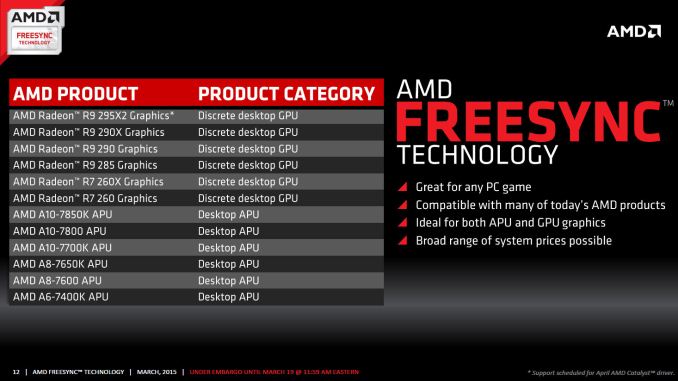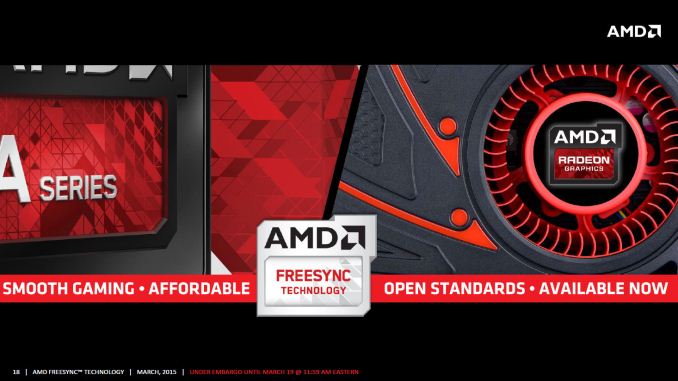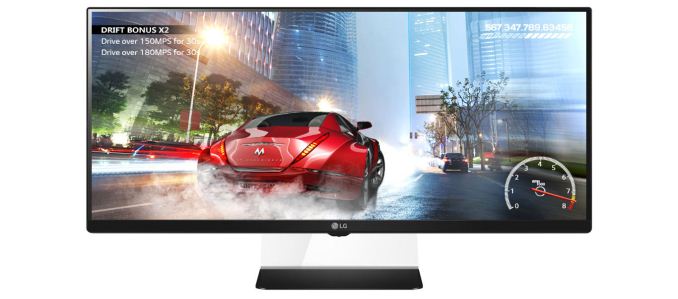The AMD FreeSync Review
by Jarred Walton on March 19, 2015 12:00 PM ESTClosing Thoughts
It took a while to get here, but if the proof is in the eating of the pudding, FreeSync tastes just as good as G-SYNC when it comes to adaptive refresh rates. Within the supported refresh rate range, I found nothing to complain about. Perhaps more importantly, while you’re not getting a “free” monitor upgrade, the current prices of the FreeSync displays are very close to what you’d pay for an equivalent display that doesn’t have adaptive sync. That’s great news, and with the major scaler manufacturers on board with adaptive sync the price disparity should only shrink over time.
The short summary is that FreeSync works just as you’d expect, and at least in our limited testing so far there have been no problems. Which isn’t to say that FreeSync will work with every possible AMD setup right now. As noted last month, the initial FreeSync driver that AMD provided (Catalyst 15.3 Beta 1) only allows FreeSync to work with single GPU configurations. Another driver should be coming next month that will support FreeSync with CrossFire setups.
Besides needing a driver and FreeSync display, you also need a GPU that uses AMD’s GCN 1.1 or later architecture. The list at present consists of the R7 260/260X, R9 285, R9 290/290X/295X2 discrete GPUs, as well as the Kaveri APUs – A6-7400K, A8-7600/7650K, and A10-7700K/7800/7850K. First generation GCN 1.0 cards (HD 7950/7970 or R9 280/280X and similar) are not supported.
All is not sunshine and roses, however. Part of the problem with reviewing something like FreeSync is that we're inherently tied to the hardware we receive, in this case the LG 34UM67 display. Armed with an R9 290X and running at the native resolution, the vast majority of games will run at 48FPS or above even at maximum detail settings, though of course there are exceptions. This means they look and feel smooth. But what happens with more demanding games or with lower performance GPUs? If you're running without VSYNC, you'd get tearing below 48FPS, while with VSYNC you'd get stuttering.
Neither is ideal, but how much this impacts your experience will depend on the game and individual. G-SYNC handles dropping below the minimum FPS more gracefully than FreeSync, though if you're routinely falling below the minimum FreeSync refresh rate we'd argue that you should lower the settings. Mostly what you get with FreeSync/G-SYNC is the ability to have smooth gaming at 40-60 FPS and not just 60+ FPS.
Other sites are reporting ghosting on FreeSync displays, but that's not inherent to the technology. Rather, it's a display specific problem (just as the amount of ghosting on normal LCDs is display specific). Using higher quality panels and hardware designed to reduce/eliminate ghosting is the solution. The FreeSync displays so far appear to not have the same level of anti-ghosting as the currently available G-SYNC panels, which is unfortunate if true. (Note that we've only looked at the LG 34UM67, so we can't report on all the FreeSync displays.) Again, ghosting shouldn't be a FreeSync issue so much as a panel/scaler/firmware problem, so we'll hold off on further commentary until we get to the monitor reviews.
One final topic to address is something that has become more noticeable to me over the past few months. While G-SYNC/FreeSync can make a big difference when frame rates are in the 40~75 FPS range, as you go beyond that point the benefits are a lot less clear. Take the 144Hz ASUS ROG Swift as an example. Even with G-SYNC disabled, the 144Hz refresh rate makes tearing rather difficult to spot, at least in my experience. Considering pixel response times for LCDs are not instantaneous and combine that with the way our human eyes and brain process the world and for all the hype I still think having high refresh rates with VSYNC disabled gets you 98% of the way to the goal of smooth gaming with no noticeable visual artifacts (at least for those of us without superhuman eyesight).
Overall, I’m impressed with what AMD has delivered so far with FreeSync. AMD gamers in particular will want to keep an eye on the new and upcoming FreeSync displays. They may not be the “must have” upgrade right now, but if you’re in the market and the price premium is less than $50, why not get FreeSync? On the other hand, for NVIDIA users things just got more complicated. Assuming you haven’t already jumped on the G-SYNC train, there’s now this question of whether or not NVIDIA will support non-G-SYNC displays that implement DisplayPort’s Adaptive Sync technology. I have little doubt that NVIDIA can support FreeSync panels, but whether they will support them is far less certain. Given the current price premium on G-SYNC displays, it’s probably a good time to sit back and wait a few months to see how things develop.
There is one G-SYNC display that I’m still waiting to see, however: Acer’s 27” 1440p144 IPS (AHVA) XB270HU. It was teased at CES and it could very well be the holy grail of displays. It’s scheduled to launch next month, and official pricing is $799 (with some pre-orders now online at higher prices). We might see a FreeSync variant of the XB270HU as well in the coming months, if not from Acer than likely from some other manufacturer. For those that work with images and movies as well as playing games, IPS/AHVA displays with G-SYNC or FreeSync support are definitely needed.
Wrapping up, if you haven’t upgraded your display in a while, now is a good time to take stock of the various options. IPS and other wide viewing angle displays have come down quite a bit in pricing, and there are overclockable 27” and 30” IPS displays that don’t cost much at all. Unfortunately, if you want a guaranteed high refresh rate, there’s a good chance you’re going to have to settle for TN. The new UltraWide LG displays with 75Hz IPS panels at least deliver a moderate improvement though, and they now come with FreeSync as an added bonus.
Considering a good display can last 5+ years, making a larger investment isn’t a bad idea, but by the same token rushing into a new display isn’t advisable either as you don't want to end up stuck with a "lemon" or a dead technology. Take some time, read the reviews, and then find the display that you will be happy to use for the next half decade. At least by then we should have a better idea of which display technologies will stick around.













350 Comments
View All Comments
Cerb - Saturday, March 21, 2015 - link
If it's not working, this is just as wrong. Since it's fairly close, at 24, 25, or almost 30, you will see the tear line creeping up or down the image, if vsync isn't on. It's exceptionally obvious. Usually, you will just see skipped frames on Windows, since the compositor forces vsync for the desktop, and this is generally well-supported by any video player's playback mechanisms. The skipped frames become more noticeable as you watch, but aren't nearly as bad as tearing.looncraz - Saturday, March 21, 2015 - link
Tearing can happen anytime.I'm writing a compositing engine for HaikuOS and I would LOVE to be able to control the refresh timing! when a small update occurs, and the frame buffer is ready, I'd swap it, trigger a monitor refresh, and then be on my way right away.
As it stands, I have to either always be a frame behind, or try and guess how long composing the frame buffer from the update stream will take before I know anything about what the update stream will be like so I know when to wake up the composite engine control loop.
That means, even on normal day-to-day stuff, like opening a menu, dragging icons, playing solitaire, browsing the web, etc. FreeSync would be quite useful. As it stands, the best I can do is hope the frame is ready for the next interval, or wait until the next refresh is complete to swap frame buffers - which means that the data on screen is always a frame out of date (or more).
At 60hz that is a fixed delay multiplier of 16.7, with a minimum multiplicand of 1. Going with higher refresh rates on the desktop is just wasteful (we don't really need 60, except for things to feel smooth due to the delay multiplier effect of the refresh rate).
If I could use the whole range from 45hz to 75 hz, our (virtual) multiplicand could be 0.75-1.33, instead of exactly 1 or 2. That make a significant difference in jitter.
Everything would be smoother - and we could drop down to a 45hz refresh interval by default, saving energy in the process, instead of being stuck at at a fixed cadence.
Cerb - Saturday, March 21, 2015 - link
Wrong. it is generating the visuals, and doing so the exact same way, as far as any of this technology is concerned, and screen tearing does happen, because refresh rates vary from our common ones.soccerballtux - Friday, March 20, 2015 - link
considering the power saving impact it's had on the mobile sector (no sense rendering to pixels that haven't changed, just render to the ones that have), it most definitely would have a significant impact on the laptop market and would be a great 'green' tech in general.erple2 - Friday, March 20, 2015 - link
No value, except to the consumer that doesn't have to pay the (current) $160+ premium for g-sync. Now, if amd had a gfx card competitor to the gtx980, it'd be marvelous, and a no brainer. Given that the cost is apparently minimal to implement, I don't see that as a problem. Even if you think it's not value added, panel manufacturers shoved the pointless 3d down everyone's throat, so clearly, they're not averse to that behavior.mdriftmeyer - Sunday, March 22, 2015 - link
It has value for any animated sequence.JonnyDough - Monday, March 23, 2015 - link
Inside of gaming it has plenty of value - who even cares about the rest? Gaming was a $25.1 billion market in 2010 (ESA annual report). I'd take a billionth of that pie and go out for a nice meal wouldn't you?dragonsqrrl - Thursday, March 19, 2015 - link
... No current or upcoming DP spec ...requires... adaptive sync. It's optional, not sure how else you could interpret that, especially when you take the comment I responded to into consideration.eddman - Friday, March 20, 2015 - link
Wait a minute; that only applies to monitors, right? It'd suck to buy a DP 1.2a/3 video card and find out that it cannot do adaptive-sync.tobi1449 - Friday, March 20, 2015 - link
Plus FreeSync != Adaptive Sync